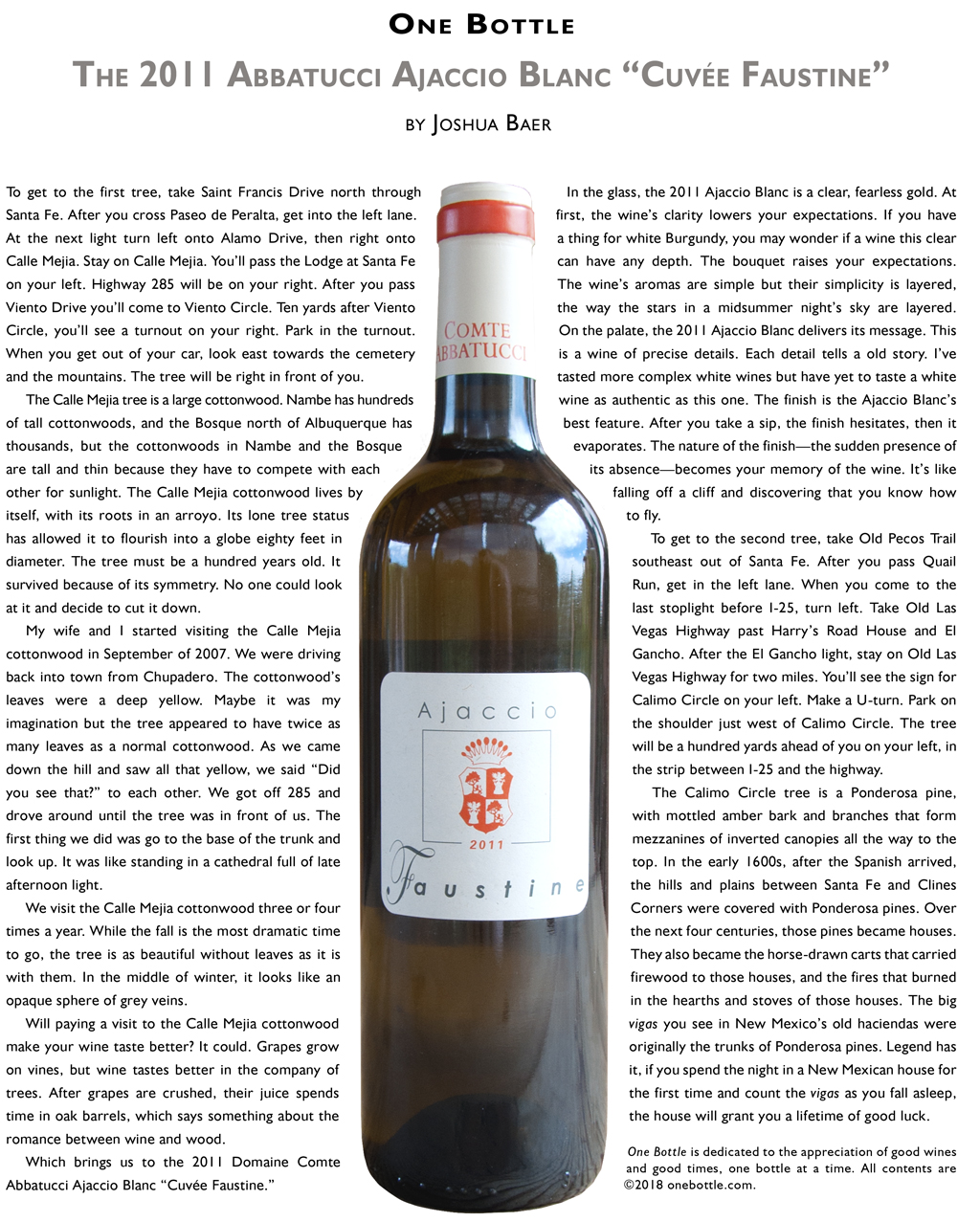2011 Abbatucci Ajaccio Blanc “Cuvée Faustine”
To get to the first tree, take Saint Francis Drive north through Santa Fe. After you cross Paseo de Peralta, get into the left lane. At the next light turn left onto Alamo Drive, then right onto Calle Mejia. Stay on Calle Mejia. You’ll pass the Lodge at Santa Fe on your left. Highway 285 will be on your right. After you pass Viento Drive you’ll come to Viento Circle. Ten yards after Viento Circle, you’ll see a turnout on your right. Park in the turnout. When you get out of your car, look east towards the cemetery and the mountains. The tree will be right in front of you.
The Calle Mejia tree is a large cottonwood. Nambe has hundreds of tall cottonwoods, and the Bosque north of Albuquerque has thousands, but the cottonwoods in Nambe and the Bosque are tall and thin because they have to compete with each other for sunlight. The Calle Mejia cottonwood lives by itself, with its roots in an arroyo. Its lone tree status has allowed it to flourish into a globe eighty feet in diameter. The tree must be a hundred years old. It survived because of its symmetry. No one could look at it and decide to cut it down.
My wife and I started visiting the Calle Mejia cottonwood in September of 2007. We were driving back into town from Chupadero. The cottonwood’s leaves were a deep yellow. Maybe it was my imagination but the tree appeared to have twice as many leaves as a normal cottonwood. As we came down the hill and saw all that yellow, we said “Did you see that?” to each other. We got off 285 and drove around until the tree was in front of us. The first thing we did was go to the base of the trunk and look up. It was like standing in a cathedral full of late afternoon light.
We visit the Calle Mejia cottonwood three or four times a year. While the fall is the most dramatic time to go, the tree is as beautiful without leaves as it is with them. In the middle of winter, it looks like an opaque sphere of grey veins.
Will paying a visit to the Calle Mejia cottonwood make your wine taste better? It could. Grapes grow on vines, but wine tastes better in the company of trees. After grapes are crushed, their juice spends time in oak barrels, which says something about the romance between wine and wood.
Which brings us to the 2011 Domaine Comte Abbatucci Ajaccio Blanc “Cuvée Faustine.”
In the glass, the 2011 Ajaccio Blanc is a clear, fearless gold. At first, the wine’s clarity lowers your expectations. If you have a thing for white Burgundy, you may wonder if a wine this clear can have any depth. The bouquet raises your expectations. The wine’s aromas are simple but their simplicity is layered, the way the stars in a midsummer night’s sky are layered. On the palate, the 2011 Ajaccio Blanc delivers its message. This is a wine of precise details. Each detail tells a old story. I’ve tasted more complex white wines but have yet to taste a white wine as authentic as this one. The finish is the Ajaccio Blanc’s best feature. After you take a sip, the finish hesitates, then it evaporates. The nature of the finish—the sudden presence of its absence—becomes your memory of the wine. It’s like falling off a cliff and discovering that you know how to fly.
To get to the second tree, take Old Pecos Trail southeast out of Santa Fe. After you pass Quail Run, get in the left lane. When you come to the last stoplight before I-25, turn left. Take Old Las Vegas Highway past Harry’s Road House and El Gancho. After the El Gancho light, stay on Old Las Vegas Highway for two miles. You’ll see the sign for Calimo Circle on your left. Make a U-turn. Park on the shoulder just west of Calimo Circle. The tree will be a hundred yards ahead of you on your left, in the strip between I-25 and the highway.
The Calimo Circle tree is a Ponderosa pine, with mottled amber bark and branches that form mezzanines of inverted canopies all the way to the top. In the early 1600s, after the Spanish arrived, the hills and plains between Santa Fe and Clines Corners were covered with Ponderosa pines. Over the next four centuries, those pines became houses. They also became the horse-drawn carts that carried firewood to those houses, and the fires that burned in the hearths and stoves of those houses. The big vigas you see in New Mexico’s old haciendas were originally the trunks of Ponderosa pines. Legend has it, if you spend the night in a New Mexican house for the first time and count the vigas as you fall asleep, the house will grant you a lifetime of good luck.
One Bottle is dedicated to the appreciation of good wines and good times, one bottle at a time. You can write to Joshua Baer at jb@onebottle.com.
